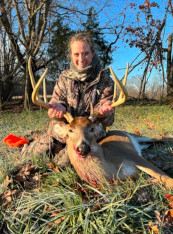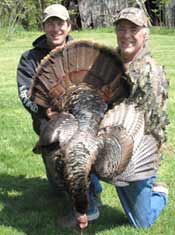NAHC: Published in:
The Early Bird Gets the Buck It’s critical to find the correct balance
between learning about a hunting property and alerting deer to your
presence. By: David Hart It’s summer, which means white-tailed deer season is just around the corner. It’s time to dust off the gear, shoot the bow and sight-in the rifle. It’s also time to locate mature bucks. But exactly how much scouting should you do during August and September? For some hunters, the answer is “as much as possible.” That’s the wrong answer, say outfitters Chris McClellan of Virginia and Josh Cobb of Iowa. Traipsing through the woods during the summer is a great way to spend time outdoors, and it can unlock the mysteries of the previous deer season. However, Cobb, who owns Medicine Creek Outfitters in southern Iowa, is convinced that the less in-the-woods scouting he does, the better are his chances of tagging a trophy-class buck. He says spooking a buck once won’t bother him too much, at least not if it happens months prior to opening day. Cobb figures a mature deer that was run out of his bedding area in the summer will return within a day or two. Spooking him twice, however, could have catastrophic results, especially if the season is right around the corner. “If you bump the same buck two or three times a couple of weeks before the hunting season, he’ll either abandon that area completely, or he’ll go nocturnal,” Cobb warned. “Either way, he’ll be very tough to pattern. I’ve heard hunters say that if you scout a lot, then the deer will get used to you and continue to stay on their patterns. That’s not a chance I want to take.” Sailor’s Creek Outfitters Owner McClellan agrees, adding, “I want to spend as little time in the woods as I can, especially during the weeks leading up to the start of the season.” McClellan will, however, scout heavily during January, February and March, looking for obvious deer sign such as well-worn trails, rub lines and shed antlers. Both are far easier to see during the winter when there are no leaves on the trees. If there is a time to push deer around, the post-season period is it. McClellan isn’t worried at all about bumping deer from their bedding areas. In fact, he’s actually happy to see white flags because late-winter bedding areas are likely late-season bedding areas. “If I jump deer in the middle of the day in February,” he said, “I’m confident those are the same places they’ll bed after they’ve been pressured during the hunting season, so I can use that knowledge for the last few weeks of our gun season next year. I’ll put a stand on the edge of thicker bedding cover like grown-up pines or a thick creek-bottom for my late-season hunts.” Cobb agrees. He says whitetails follow different routines during the late season as hunting pressure increases and food sources change. Like McClellan, he wants to locate late-season bedding areas, something he’ll do right after Iowa’s last gun season closes. Instead of scouring the woods day after day prior to hunting season, McClellan instead prefers low-impact scouting, entering the woods only when he has a carefully planned mission in mind. Whether he’s checking new land, shifting stands or looking for new food sources, McClellan will make a quick pass through the woods during the middle of the day. He’s in and out in a matter of an hour or so, deciphering all the deer sign he notices in order to make a decision on where to place a stand. Cobb also keeps his August and later scouting to a minimum, often entering a block of timber just once during late summer to look for sign and hang tree-stands. “I can usually find a good stand location in just an hour or two,” he said. “I’m looking for the heaviest trails, fence crossings, creek crossings, rub lines and even old scrapes. They’ll often use those right though our early bow season. I’ll scout and place stands on the same day.” Of course, the buck that made last season’s sign might be on someone’s wall, but Cobb and McClellan say if an area held a big buck last year, there’s a good chance it will hold a new buck this season. That’s why Cobb might not even scout some land at all if he’s already familiar with it. He’ll rely on past scouting trips and hunter/client observations to make decisions about the upcoming season. He says unless some major change has taken place on that property, there’s little reason to believe this year’s deer will behave any differently than last year’s. McClellan agrees, adding that new bucks will continue to use the same rub lines and scrape lines year after year. Whitetails will also bed in the same general areas every year and travel the same trails to and from feeding areas. Cobb, however, did have to get reacquainted with a farm he’s been hunting for years after the landowner took fields out of the Conservation Reserve Program and planted them in row crops. Not only did the deer start using those crop fields, new deer moved in. “I had to relearn deer movement patterns because they changed drastically,” he recalled. Cobb made a quick pass along the crop field edges a month before he started hunting that property and then followed deer trails to known bedding areas. He hung several tree-stands the same day so he could change locations based on wind direction. No one entered that property again until hunting season was under way. McClellan will also check on deer activity around early season food sources in the weeks leading up to the season. Nothing matters more during the October bow season than the white oaks generously scattered around the 3,000-acre farm he hunts. And while the oaks might be producing a bumper crop on one part of the farm, they could be bone-dry on another. He has to keep tabs on them, but how he checks the acorns depends largely on the weather. “If it’s breezy, I’ll come in downwind and make a quick pass to see if there are acorns, and if there’s a good amount of deer activity under the trees,” McClellan said. “I avoid walking anywhere near a bedding area that time of year. If there is no wind, I can stop within 50 yards or so and just listen for acorns hitting the leaves. If it’s a good crop, there will be so many it will sound like it’s raining. If there are that many acorns falling in one area, and if I already have a stand in the right location, I’ll just back out and leave. That’s all I need to know.” No matter how close he gets to those oaks, McClellan always wears rubber boots, and he never enters an area during the peak deer movement hours of the morning and evening. There’s certainly a chance he’ll bump deer during the middle of the day, but the odds are much lower. Like Cobb, he’s not too worried about spooking deer months prior to hunting season, but as opening day draws closer, he wants to disturb them as little as possible. If he must enter a hunting area, McClellan will actually drive as close to a stand as he can. He’s watched countless deer feed just yards from a truck or an ATV as it passes them, but once the driver stops and gets out, the deer bolt. Both outfitters are convinced deer become conditioned to farmers who regularly drive through a property as they check on cattle or crops. The vehicle doesn’t pose a threat. However, a human on foot is a different story. Hitting The Road Cobb spends an estimated 95 percent of his scouting time behind the wheel of his truck, watching deer with binoculars as they enter and exit feeding areas prior to sunset. Southern Iowa is fairly open country with vast corn fields interspersed with blocks of timber and wooded creek bottoms. The hilly terrain is perfect for long-distance scouting, and Cobb prefers to stay at least 300 yards away from a field he’s watching. If he can’t see it without driving closer, he’ll sneak in on foot using the terrain to stay out of sight as much as possible, stopping at least a couple- hundred yards from the food plot or grain field where he expects to see deer. “I do everything I can to get in and out without those deer knowing I was there,” he said. “I’ll scout just like I was trying to hunt a big buck. I use the wind to my advantage, and I won’t go into an area to look if conditions aren’t right.” The land McClellan hunts is also hilly, but the habitat consists largely of continuous blocks of mature forests and planted pines. There are plenty of fields, but many aren’t large enough to sit and watch without potentially spooking the deer that might feed in them. That’s why McClellan prefers to scout a little later in the evening—as in, after dark—with a spotlight. It’s legal in Virginia to spotlight with landowner permission (as long as there is no gun in the vehicle), so he’ll take full advantage of the opportunity, driving from field to field under the cover of darkness throughout August and September to see what’s out there. (Spotlighting is illegal in many states, so check your local laws before you try a night survey.) “I’m spotlighting to take inventory of the bucks I want to put hunters on when the season opens,” he said. “I’ll also watch around sunset with binoculars to see where they are coming in and out of the fields, but spotlighting shows me a whole lot more deer than I’ll ever see by watching a single field right before dark. It’s pretty amazing how many bucks I see that are nowhere to be found during daylight.” Cobb also used to check fields at night with the help of a spotlight, but not anymore. “I’ve had cops check on me on several occasions, and I just don’t like knowing they have to come out to see who’s spotlighting when it’s just me,” he said. “I let my trail cameras do my nighttime scouting for me now.” Instead, Cobb has a milk-run of stops that allow him to scan a dozen or more fields within the last hour of light, spending just a few minutes at each. Occasionally, he’ll reverse his route just to make sure a big buck isn’t coming into one of the first fields he watches at last light. If he does see a buck worth pursuing, Cobb will get there early enough to see where the buck enters the field. By doing that, he’ll know exactly where to set up a ground blind or tree-stand. He says he’ll start focusing on individual bucks right before the season in an effort to nail down their patterns. Finding Pressured Bucks McClellan will continue to spotlight well into hunting season, focusing on winter food plots and other food sources. After deer have been pressured, they often stay in deep cover during daylight hours, venturing onto fields only under the cover of darkness. By shining a light on feeding deer, McClellan can shift his hunting efforts to those areas with the best bucks. “I can check on rut activity because buck will chase does even when I’ve got a light on them, although it’s best not to keep it on them too long,” he said. “I’ve also seen quite a few new bucks at night during the season that came in from adjoining land, so I can move my hunters to those areas if I see something worth going after.” One thing neither outfitter will do is walk through the woods in an effort to find a new spot to hunt during the season. Cobb says that’s a sure way to burn a spot. Of course, if you scout just enough during summer and early fall, you shouldn’t have to find a new spot during the season. Red Vs. White Acorns Finding acorns during a good year isn’t enough—you have to be able to determine if it’s from a white oak or red oak. Whitetails will eat both, but they greatly prefer white oak acorns, which have less tannin in them and are therefore less bitter. So how can you tell? As a rule, white oak leaves have rounded lobes, while the leaves of various red oaks have pointed tips. The acorns also look different, and the easiest way to tell red oak acorns from white oak acorns is to look at the caps. The inner surface of the cap of a white oak is “hairless,” while the red oak acorn cap will appear hairy. The tree bark is also different. A white oak’s bark is “shaggy” and the outer layers can be peeled with your fingers; a red oak’s bark is solid.–DAVID HART Photos
Comments By Mr. Cee @ Saturday, August 07, 2010 1:52 PM This article is so true about not scouting much except for post season. I have myself spent more times in the woods in Mid Jan. to late Feb. just after the archery season is over and it has paid off well for me in the fall when archery is beginning because I go to the same proven areas I have always hunted and more Bucks every year are using the same travel routes as previous years and all I basically do is play the wind with these areas and I have fairly well success. |







